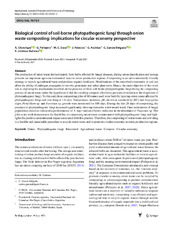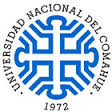- RDI Principal
- →
- Facultad de Ciencias Agrarias
- →
- Artículos
- →
- Ver ítem
JavaScript is disabled for your browser. Some features of this site may not work without it.
Mostrar el registro sencillo del ítem
| dc.creator | Chorolque, A. | |
| dc.creator | Pellejero, G. | |
| dc.creator | Sosa, M.C. | |
| dc.creator | Palacios, J. | |
| dc.creator | Aschkar, G. | |
| dc.creator | García Delgado, C. | |
| dc.creator | Jiménez Ballesta, R. | |
| dc.date | 2021 | |
| dc.date.accessioned | 2021-08-23T13:37:54Z | |
| dc.date.available | 2021-08-23T13:37:54Z | |
| dc.identifier | http://rdi.uncoma.edu.ar/handle/uncomaid/16296 | |
| dc.identifier.issn | 2319-7064 | es_ES |
| dc.description.abstract | The production of onion waste derived mainly from bulbs affected by fungal diseases, during onion classification and storage presents an important agro-environmental issue in onion production regions. Composting is an environmentally friendly strategy to recycle agricultural waste and produce organic fertilizers. Modifications of the microbial community in soil can affect the ability of pathogen propagules to survive, germinate and infect plant roots. Hence, the main objective of this work was to exploring the mechanisms involved on the presence of three soil-borne phytopathogenic fungi during the composting process of onion waste under the hypothesis if that the resulting compost effectively prevents or minimizes the dispersion of phytopathogenic fungi. To this end, three composting piles of 60 tonnes each were built by layering onion waste affected by phytopathogenic fungi and cow dung at 1:1 ratio. Temperature, moisture, pH, electrical conductivity (EC) and Aspergillus niger, Penicillium sp. and Fusarium sp. growth were monitored for 100 days. During the first 28 days of composting, the presence of phytopathogenic fungi increased significantly showing thereafter a downward trend. Final estimations of fungal populations densities indicated a predominance of A. niger and an effective reduction in the abundance of Fusarium sp. This pilot-scale work demonstrates the feasibility of composting onion waste contaminated with phytopathogenic fungi and high- lights the positive environmental impact associated with this practice. Therefore, the composting of onion waste and cow dung is a feasible and sustainable procedure to recycle onion waste and to promote circular economy in onion production regions. | es_ES |
| dc.format | application/pdf | es_ES |
| dc.language | eng | es_ES |
| dc.publisher | Springer | es_ES |
| dc.publisher | M. Shabani | es_ES |
| dc.relation.uri | https://doi.org/10.1007/s13762-021-03561-2 | es_ES |
| dc.relation.uri | https://link.springer.com/article/10.1007%2Fs13762-021-03561-2 | es_ES |
| dc.rights | Atribución-NoComercial-CompartirIgual 2.5 Argentina | es_ES |
| dc.rights.uri | https://creativecommons.org/licenses/by-nc-sa/2.5/ar/ | es_ES |
| dc.source | International Journal of Environmental Science and Technology | es_ES |
| dc.subject | Onion | es_ES |
| dc.subject | Phytopathogenic fungi | es_ES |
| dc.subject | Biocontrol | es_ES |
| dc.subject | Agricultural waste | es_ES |
| dc.subject | Compost | es_ES |
| dc.subject | Circular economy | es_ES |
| dc.subject.other | Ciencias de la Tierra y Medio Ambiente | es_ES |
| dc.title | Biological control of soil-borne phytopathogenic fungi through onion waste composting: implications for circular economy perspective | es_ES |
| dc.type | Articulo | es |
| dc.type | article | eu |
| dc.type | acceptedVersion | eu |
| dc.description.fil | Fil: Chorolque, A. Universidad Nacional del Comahue. Centro Regional Zona Atlántica; Argentina. | es_ES |
| dc.description.fil | Fil: Pellejero, G. Universidad Nacional del Comahue. Centro Regional Zona Atlántica; Argentina | es_ES |
| dc.description.fil | Fil: Sosa, M.C. Universidad Nacional del Comahue. Facultad de Ciencias Agrarias; Argentina. | es_ES |
| dc.description.fil | Fil: Palacios, J. Universidad Nacional del Comahue. Centro Regional Zona Atlántica; Argentina. | es_ES |
| dc.description.fil | Fil: Aschkar, G. Universidad Nacional del Comahue. Centro Regional Zona Atlántica; Argentina. | es_ES |
| dc.description.fil | Fil: García Delgado, C. Autonomous University of Madrid. Department of Geology and Geochemistry; Spain. | es_ES |
| dc.description.fil | Fil: Jiménez Ballesta, R. Autonomous University of Madrid. Department of Geology and Geochemistry; Spain. | es_ES |
| dc.cole | Artículos | es_ES |



